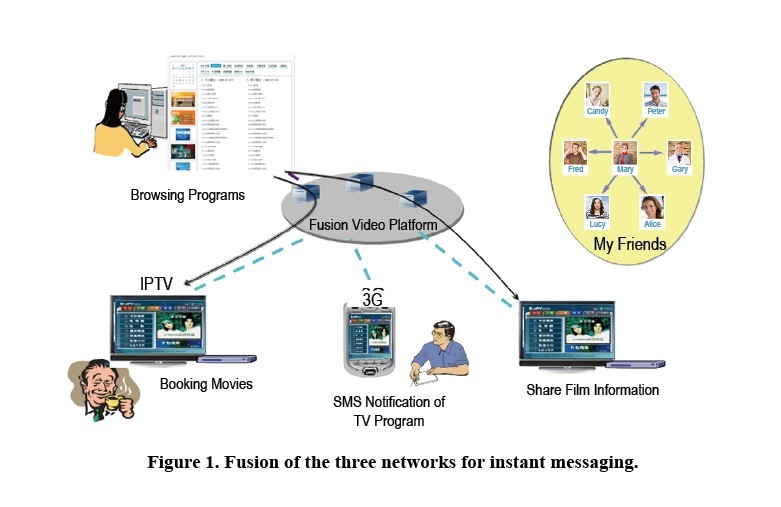Social TV Is Entering Households
Social television is “a general term for technology that supports communication and interaction in the context of watching television, or related to TV content. It also includes the study of television-related social behavior.” Simply put, social TV allows subscribers to engage in TV-related social networking such as communicating and interacting with others while watching TV. Social TV doesn’t just support social networking websites, it is also supports social networking through other technologies and platforms.
In the era of Web 2.0, the purpose of social TV can be summed up as enabling subscribers in different places to share and discuss TV programs conveniently using social networking tools. For example, subscribers can discuss popular TV dramas, celebrate goals during a live sports match, and alert each other to certain programs.
Social TV is a new term whose meaning is still not clearly defined. Social TV is more of a software concept than a hardware one. Subscribers need software to communicate with each other.
A social TV network has the potential to grow into a large-scale platform that integrates a wide range of applications, such as instant messaging, content searching, TV program recommendation and ranking, and video conferencing. The platform is open and allows third parties to develop new applications and share profit.
The large-scale social TV system designed by ZTE is based on existing IPTV and converges TV, PC and mobile phone screens. It is a portal to services such as social networking, entertainment, and recreational activities on a single website. The system helps improve user experience and customer retention rate.
Features
● a high degree of convergence. The system integrates most applications and services sought after by the majority of customers. These include motion sensing games, online games, online reading, chat rooms, emailing, instant messaging, RSS, blogging, online data storage and third party communities. It is a highway to the virtual world, providing access to all sorts of information and experiences.
● different access methods. Different access methods include WEB, WAP, mobile client and IPTV, and subscribers can access the system conveniently. No matter what access method is used, the interfaces of the access devices can be personalized with consistent style.
● powerful search engine. The system’s powerful search engine allows subscribers to search information quickly and with precision. By using the inverse order indexing technique and a highly efficient data update check mechanism, the system maintains and processes the index for changed data with high efficiency. This provides high-quality search services for various applications. The system also supports flexible word library processing.
● enhanced user experience. The system allows IPTV operators to improve user experience by providing value-added services. By encouraging more communication between TV viewers and facilitating interaction between broadcasters and audience, social TV will greatly improve program ratings. By integrating applications and services, social TV offers a brand new user experience of TV.
Business Model 1
Fusion of the three networks for instant messaging
Working with TVMS system, social TV enables messages to be displayed in the form of scrolling and static subtitles on the interfaces of the subscriber message releasing system. Using an SMS gateway, the system can push messages to mobile phones defined by users. With a platform that fuses cable TV, the telecommunication network, and the Internet, the system can push messages to PCs and handheld devices, making it convenient for subscribers to view messages anytime anywhere.

Abundant user applications
With social TV, subscribers can purchase products, book tickets, and pay fees.
Equipped with a touch screen, each TV set allows the subscriber to find locations and routes conveniently on online e-maps such as Google Maps. The system also advertises nearby supermarkets, provides traffic information, gives weather forecasts, local and community news and notices.
Business Model 2
Third-party (government, businesses) information releasing
Third parties such as government agencies and businesses can use social TV system to release information to subscribers.
The information releasing subsystem can obtain content such as weather forecast and RSS news from internet and publish them in the TV system.
Online survey by third-party survey organizations
The information releasing subsystem also provides online voting and quizzing service. Third-party survey organizations can distribute questionnaires to subscribers to get feedback.
Interactive forum
Using terminal devices such as remote controller, PC and mobile phone, subscribers can post topics and questions on the forum of the information releasing subsystem. The answers to the questions can be sent to the terminal devices in user-customized manners.
Wide range of application
The social TV system can be installed in residential complexes, large hotels, airports and subway stations and cater to the needs of different users. It can also be used as an effective tool for education and training, and serving as information infrastructure in rural areas.
Conclusion
Social TV puts more emphasis on social networking. It is more like a social networking website attached to cable TV system. Activities such as TV viewing, social networking, interacting are carried out by the basic devices―TV set and set-top box.
Social TV provides a wide range of value-added services and applications such as viewing TV programs on multiple devices, time-shifting TV, Karaoke, TV photo book, household security, video call, intelligent home, TV shopping, TV payment, bringing great convenience to subscribers. Moreover, social TV can help operators upgrade their IPTV service and provide full services to subscribers by further fusing the cable TV network, telecommunication network, and Internet.